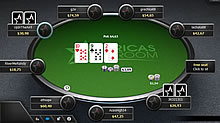This form of poker has been around for many years - formerly called Paduki, it was first played in South Korea - but only recently has it made its way into the poker mainstream. Currently, Badugi is offered in many B&M casinos at high stakes only, and at a few select online poker sites for all kinds of stakes, all the way down to play money. It's a seemingly-simple and yet complicated game that combines elements from many other standard poker games. Moreover, it's action-packed and full of interesting decisions, which accounts for the game's current growth in popularity.
Badugi is triple-draw game, meaning that each player gets three chances to draw and hopefully improve his hand. It's also a lowball game, which means that the best low hand always wins. In this respect, the hand rankings are similar to the low hand rankings in games such as Omaha hi-lo and Stud hi-lo (you want the lowest possible hand, ranked from the highest card on down; pairs don't count and in fact work against you; aces are always low), but there are two very important differences. First, the final hand will always be made from four cards, not five, and often times not all four cards will count in the final hand. Secondly, and this point is crucial, suits matter. In Badugi, the final hand must be made of all different suits. So, in trying to draw for a winning hand - you want low cards, you want un-paired cards, and you want un-matched suits.
Regardless of the rank, if you can manage to get four cards of all different ranks and suits; for example, As-3c-7d-Jh, then that hand is officially a Badugi. The absolute nuts in Badugi would be A-2-3-4 of all different suits. Any time your final hand contains a pair, or two cards of the same suit, that counterfeits one of your cards, making that card worthless. When this happens, your hand then becomes a three-card hand (for example, Ac-3-d-3s-7h, or 2d-3d-6-s-8h), or a two-card hand (for example, A-s-Ah-5s-5c, or 3h-4h-5d-6d) or in a few cases, a one-card hand (your hold four-of-a-kind, or four cards all of the same suit). Needless to say, one-card hands are the absolute bottom of the barrel, two-card hands are scarcely better - and neither should be played. Three-card hands are playable, and you will see quite a few of these at the showdown. Of course any Badugi beats a three-card hand, any three-carder beats a two-carder, and so forth.
Badugi hands ranked from least powerful to most powerful (4-3-2-A):






As stated above, this is a triple-draw game, with four rounds of betting. Just as in regular draw poker, you can replace any or all of your cards during a draw, or you can stand pat. And just like hold'em, there is a small and big blind. You get your first four cards, then there's a round of betting. First draw, then another round of betting. Second draw, yet another round of betting. Third and final draw, final round of betting. Right now, Badugi is typically played as a limit, pot-limit, or half-pot-limit game. Oddly enough it's the half-pot-limit games that really build the biggest pots, as many players get pushed out of the hand in the early rounds of the pot-limit games.
As with all forms of poker, starting hand selection is crucial, because in Badugi, just like in all other forms of poker, most people will play far too loose. Double suited and/or double-paired starting hands should be tossed without a second thought. Ideally in this game, you want your hand to be a Badugi that's at most an 8-high, and to get there you need to begin with at least three good cards - unpaired, unmatched, and as low as possible. If you start with such a hand, you should not have to draw for more than one card at a time. In fact, with the possible exception of taking two cards on the very first drawing round, to play this game well you should never draw for more than one card at a time. You will routinely see opponents drawing for two and three cards all the way through to the third draw, but that just means they are playing insanely loose. Don't make the same mistake.
Actually you would prefer not to draw at all on the last drawing round; by this time you should have made a good low hand. Keep in mind that at a full table with six players, it's not uncommon for the dealer to run out of cards for the final draw, in which case the discards are re-shuffled and put back into the deck - meaning that the final draw will contain a lot of high cards that were thrown away previously. And as with all other forms of poker, players who manage to make a strong hand early will bet aggressively in the first couple of rounds, to make drawing hands pay for the chance to draw out.



